Coho are different from their Chinook cousins in that they only spend an average of 18 months in salt water. They have white gums and very little spotting on their tails, and the average weight of a mature Strait of Georgia coho is 5 to 8 lbs. They do not have the strength of a Chinook, but fight laterally and jump frequently. I prefer the milder taste of coho, which have less oil content than the Chinook. A 5- or 6-lb filleted coho makes a beautiful meal for four to six people.
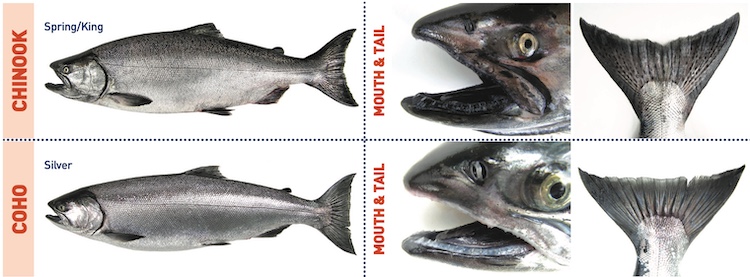
Recent Coho History
Coho historically made up the majority of the sport catch in the Strait of Georgia. They generally wintered over in the strait (I’ve encountered them in December, January, and February), and anglers started targeting them in April and May as “Bluebacks.” This fishing was typically achieved by using 4- to 6-oz slip sinkers and small red flashers trailing a red Kripple K spoon or a small pink Apex. They feed on euphausiid shrimp at this stage, and are particularly easy to catch. As summer progresses, the coho start feeding on herring, comb the depths and structure looking for bait schools, and can be targeted with downriggers and jigging gear right through mid-October.
1993 was a boom year for local coho, but in 1994 and 1995, stocks plummeted, and there was a mass migration of Strait of Georgia coho to the west coast of Vancouver Island for their whole adult life cycle. None of the fisheries scientists could pinpoint the cause for this decline, but some DFO scientists surmised that it was due to changes in the ocean salinity, probably caused by El Nino rains in the Strait of Georgia. The theory was that coho exited the strait in the fall, but when they came to re-enter in the late winter there was an abundance of fresh water at the mouth of the Juan De Fuca, and they returned to the west coast until spawning time in the east coast Vancouver Island Rivers.
Coho Migration
Even though the DNA sampling was limited in volume, these fish emanate from east coast Vancouver Island rivers, mainland rivers, the Fraser, the Capilano, and Puget Sound. Naturally, when the coho migrate to the west coast for their adult life cycle, they are not encountered in the Strait of Georgia by the Avid Anglers participating in the DNA collection program, and this makes pinpointing their origins all the more difficult.
These west coast migrations seem random in timing and intensity from year to year, but renowned fisheries scientist Dick Beamish believes that they are largely affected by easy access to food sources—krill and herring.
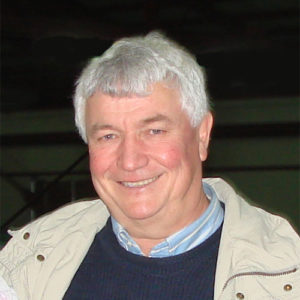
If food sources are in plentiful supply, the coho will stay close to home. An abundant food source for juvenile coho is absolutely critical to their survival rate. To my mind, this is all the more reason to terminate the commercial fisheries in the Strait of Georgia for krill and herring. According to Beamish, ocean mortality rates rose dramatically, from 85% in 1993 to 98% in the years leading up to 2013, when mortality numbers started to improve.
Today’s Coho
These days, coho experience ocean mortality at about a 95% rate. This could be due to a combination of factors, including lack of sufficient food supply or higher ocean temperatures. Naturally, populations of coho returning to the rivers declined substantially. Black Creek used to host 30,000 coho; small streams like this suffered tremendously but are now apparently recovering. Saltwater fishing license sales dropped incredibly, as coho were so easily caught by the average angler, who didn’t have the time, patience, or skills to catch Chinook. Prior to 1994, you could take your 12-ft aluminum boat out to Entrance Island, troll or jig for a couple of hours, and bring back a couple of nice coho for dinner. Coho numbers bounced around in the ensuing years, with most years being disappointing.
Coho made a fantastic resurgence in Nanaimo/Gabriola waters in 2018, probably due to increased food supply as juveniles. At that time, the retention was two hatchery fish per day per person. Be sure to check the current DFO regulations for Area 17 before retaining coho!

There has been an enhanced effort to clip the hatchery fish so we can properly differentiate them from wild fish, and DFO-funded hatcheries now fin clip one hundred percent of hatchery coho. According to Clyde Wicks (who is incredibly involved at the Nanaimo River Hatchery both fundraising and working voluntarily), at some point mechanical clippers will have to be purchased for both coho and Chinook to replace volunteers who currently do the clipping. It is likely that two Northwest Marine Technology trailers containing mechanical clippers will be purchased here in the near future with monies provided by the Government of Canada under the new Pacific Salmon Treaty. One will be for the mainland, and one for Vancouver Island.
It is estimated that in 2019 there was a ratio of 70% wild fish to 30% hatchery fish, and this holds true in catch rates reported by local fishermen. However, some of these “wild” coho are hatchery fish that did not get clipped. With the new Chinook regulations in place, it will be even more important to get all of our hatchery Chinook fin clipped, as it’s possible we may be going exclusively to hatchery Chinook retention in the future. It is futile to be releasing unclipped hatchery fish when they could be retained and fishing completed for the day.
How To Fish These Coho
Coho roam the depths. They are present at Thrasher, the Grande, and Entrance in typical Chinook water depths of 120 to 180 ft, but are also found out in 300 to 500 ft of water. Typical downrigger depths are 80 to 180 ft. Coho will hit Chinook gear with spoon leader lengths of 6 ft, but if you are targeting coho, shorten the leaders down to 4 ft and ramp up the speed from 2 knots to 2.5 or 3 knots. They do like to chase! Coho take the typical spoons in Evil Eye, Killy Magee, Kitchen Sink, and silver/blue, or hoochies in T-Rex or Blue Meanie. But they prefer the smaller 3″ spoons and needlefish hoochies.

In 2018, I was up on the structure at Entrance and Thrasher using 3″ Tomic plugs in 60 to 100 ft of water and had some incredible days catching coho. Run the plugs about thirty feet back from your clip, and make sure the plug is darting and swimming correctly by adjusting the speed between 2.5 and 3 knots. Never use flashers in front of a plug. Small plugs on light rods really highlight the fighting capabilities of coho! Purple Haze, Green Glow, and Pearl were the primary colours that turned heads.
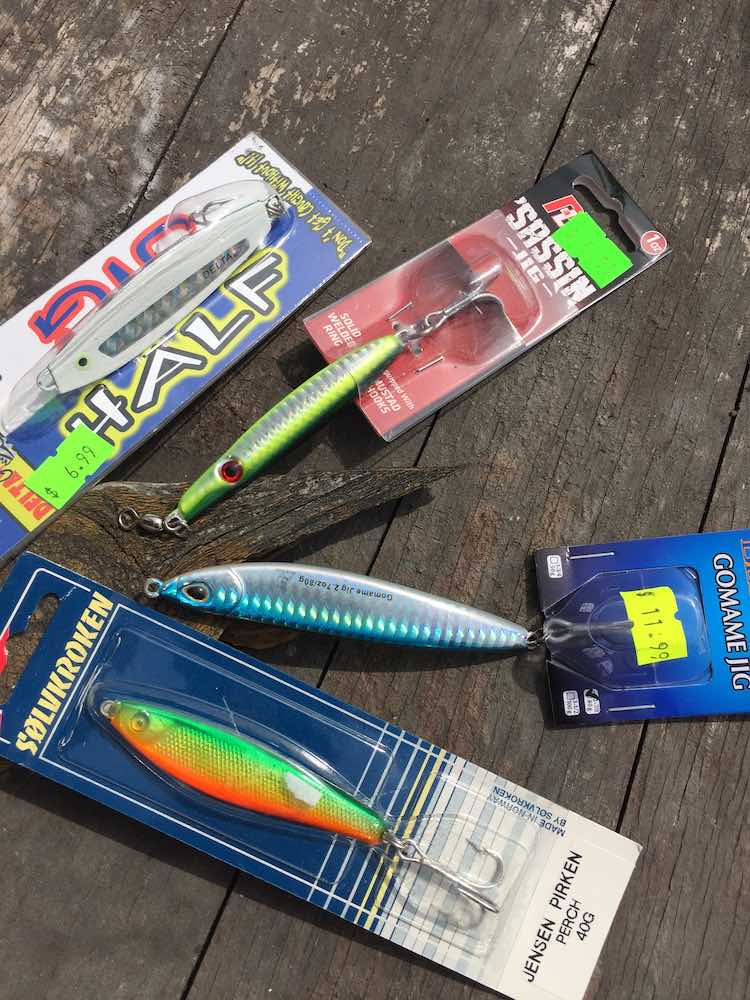
There is also a delightful shoreline Nanoose Bay fly fishing opportunity for coho in September and October. This entails wading the shoreline and casting to the schooling fish. It is fantastic when it’s on!
Bob Meyer is the Island Fisherman Area Reporter for Area 17, and owner and operator of Silver Blue Charters.
Check out this video of fishing with Bob!
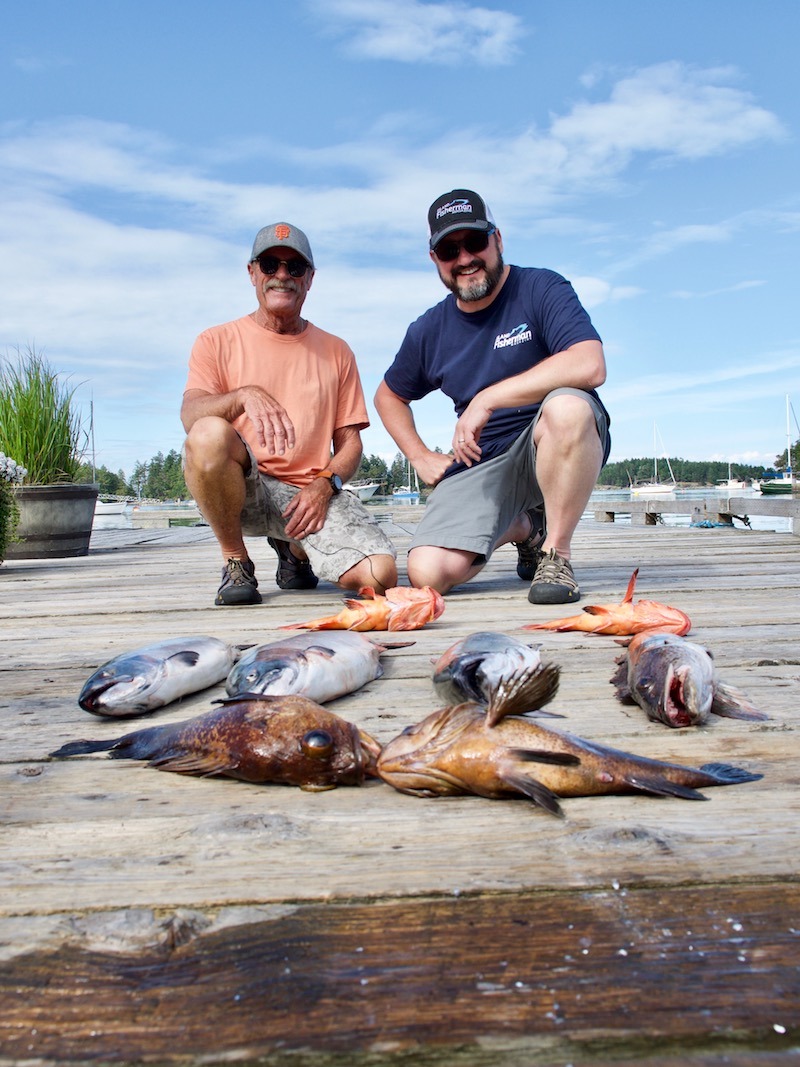


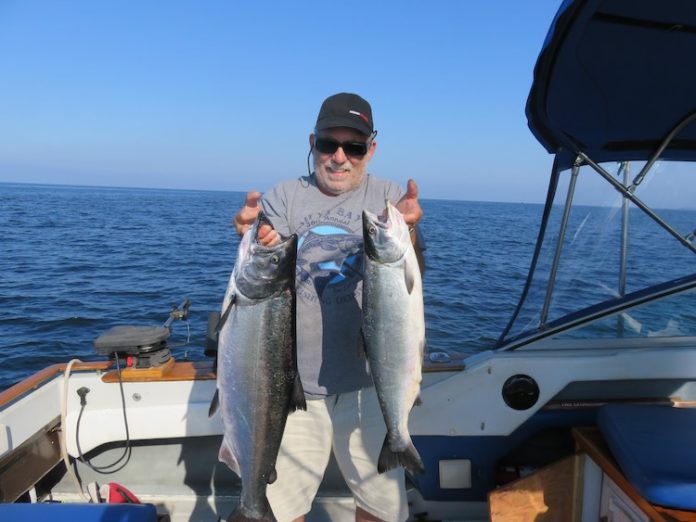




Nice article Bob,
Tom Davis
Small, black and white Apex, with or without flasher, works very well for migrating Coho.
You do have a fabulous blog thanks. Mickie Nickolai Tumer